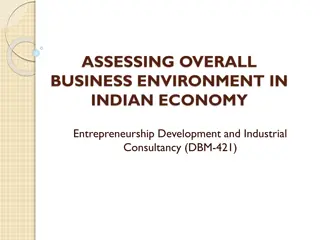Overview of Modern Business Environment in Indian Economy
Modern business in the Indian economy is characterized by large size, oligopolistic nature, diversification, global presence, technology orientation, and changing government regulations. The Indian economy features a mixed economy with both private and public enterprises, low per capita income, unequal income distribution, an agricultural base, large population, unemployment, scarcity of capital, technological backwardness, and limited entrepreneur potential. The business environment comprises external and internal factors that influence business operations.
Download Presentation

Please find below an Image/Link to download the presentation.
The content on the website is provided AS IS for your information and personal use only. It may not be sold, licensed, or shared on other websites without obtaining consent from the author. Download presentation by click this link. If you encounter any issues during the download, it is possible that the publisher has removed the file from their server.
E N D
Presentation Transcript
ASSESSING OVERALL BUSINESS ENVIRONMENT IN INDIAN ECONOMY Entrepreneurship Development and Industrial Consultancy (DBM-421)
What is business? It is referred to as an organized effort of enterprise to supply consumer with goods and services for a profit. modern business may be defined as complex field of industry and commerce which involves activities related to both production and distribution. These activities on one hand satisfy society s needs and desires and on the other hand bring profits to business firms.
Nature of modern business Large size: Modern business is large in size. Private sector Indian companies are not as large as some of the companies of developed nations in terms of sales and assets but are quite large by the standards of developing countries and are fairly comparable with a large number of middle size companies of western world e.g. Reliance, Tata, Larsen & Toubro, BharatiAirtel, Adani, etc. Oligopolistic nature: Oligopoly is characterized by small number of firms seeking a homogenous or a differentiated product. Diversification: In order to grow and expand, today business houses adopt the policy of diversification. Global presence: Economic liberalization and reduction of trade restrictions enabled business organizations to expand by doing the business overseas. Technology orientation: Modern business organizations adopt new technology to introduce new products in the market. They spend considerable amount of their budget to research oriented activities directed to adopt new technologies. Government regulations: with liberalization there is also reduction in government controls. However, government control over business organizations is also necessary to correct market failures and create stable market conditions by monetary and fiscal regulations.
Characteristic Features of Indian Economy Mixed economy: wherein both private and public enterprises prevail. Low per capita income: Unequal distribution of income and poverty: Agricultural based economy: Large population: Unemployment: Scarcity of capital: Technological backwardness: Limited Entrepreneur potential:
Business environment It refers to all the factors which have direct or indirect influence on functioning of business. It is divided into two broad categories External Environment: Includes all those factors that affect the business from outside are beyond the control of organization Internal environment: Factors which are within the control of business organization External environment is futher categorized as macro and micro environment.
Macro environmental factors Economic Environment: A close relationship exists between business and its economic factors like business cycles, inflation, unemployment interest rates, income level of saving and investments, etc. The economic factors affect consumer purchasing power and spending pattern. Economic environmental factors decide the growth prospects of business houses. Technological environment Technology implies systematic application of scientific or organized knowledge to practical tasks. Business organizations have to keep pace with the fast changing technology by adopting latest technology in their production process. The rate of change in technology also acts as opportunity or threat for existing business organizations. Technological development leads to establishment of new industries at the same time.
Macro environmental factors Political Legal Environment This refers to influence exerted by all the three constitutional wings namely legislature, executive and judiciary on business. The legislature, executive and judiciary either singly or in combination shapes, directs, develops or controls the activities of business organizations. The legal environment becomes more complicated as business organizations expand globally. A stable and dynamic political environment is very essential for business growth. Etc. Demographic Environment Demography is the study of human population with respect to size, density, location, age, sex, race, occupation and other statistics.
Macro environmental factors Socio Cultural Environment These are most difficult/ uncontrollable factors to predict The cultural environment is composed of society s basic values, perceptions, preferences and behavior, etc. Business organizations have to comply with the socio cultural environment. Natural Environment Natural forces impact business and business also influences the nature in positive and negative ways. Natural resources are of renewable and non renewable Business organizations must make efficient use of natural resources.
Assessing Overall Business Environment in India India is a key player in the world economy. The Indian economy is diversified. The diversity ranges from agriculture to latest modern technology. The contribution of agricultural activity to the GDP is less while it employs higher workforce. Market has changed from seller s market with limited competition to buyer s market with increased competition. These changes in competitive scenario also give rise to numerous entrepreneur opportunities. Changes in quantitative restrictions and tariffs to quota free and open economy with a liberalized financial market offer conducive environment for entrepreneurs.
Indian social, political and economic systems: implication for decision making by individual entrepreneurs India is a secular country. Religion is one of the cultural variables. Religion shapes the values and beliefs of a person It also has an influence on entrepreneurial behaviour type of business and women s participation in business. Socio-cultural environment encompasses all the variables which are not included in economic or political environment. The socio cultural environment include whole range of behaviors and relationships in which people engage in their private and personal lives including the characteristic of population, age, sex, race, class values and attitudes, lifestyle and relationships.
Cultural factors Culture is a phenomena exhibited by groups and this can mean society as a whole (national culture), groups within society (sub culture) or even groups of societies and nations (trans national culture many times the word "Indian culture " is used. This implies that there are certain values and way of life that Indian societies might be sharing. Social factors It includes programmes and policies of the government aimed at improving the living standards of the people of that country by better availability of public services. The social environment covers following aspects: Poverty and its alleviation programs Labor and employment Women and children development Education Health Population and family welfare Empowerment of disadvantageous groups Public committees in rural and urban areas
Major Socio cultural variables of Indian Culture Socio cultural variable Characteristics Administrative Existence of impersonal bureaucratic social relations, mistrust of fellow workers, highly centralized administration, more emphasis on hierarchical status in decision making, Bureaucratic delay, less amount of delegation, dissatisfied employees Attitude towards work and goals General and deep seated apathy, separation of work from its results, performance of tasks without any dedication, pride or interest Discipline and order Lack of discipline at all levels, Lack of trust on authority, Poor superior subordinate relationships Group Harmony Assumption of inequality of human beings, self centered behavior, suspecting fellow employees, lack of cooperation and teamwork Mostly indifferent and highly ambiva Education
Micro Environmental Factors Business organization exert some influence on micro environmental forces as compared to macro environmental forces. This includes factors such as organization market, market intermediaries, suppliers of raw material, employees etc. Business organizations sell their products with the help of market intermediaries, which include wholesalers, distributors, retailers and all other middleman. It is possible to control the activities of marketing intermediaries by providing appropriate commissions, training, other financial support etc. Suppliers are individuals and organizations that provide necessary resources for manufacturing goods or providing services. They are critical to an organization s marketing success and an important link in its value delivery system.
Environmental factors in decision making The success of any enterprise depends upon managerial decisions. Manager s decisions are also affected by environmental factors. It is, therefore, necessary that managers understand and evaluate the impact of environmental factors on their decisions.























